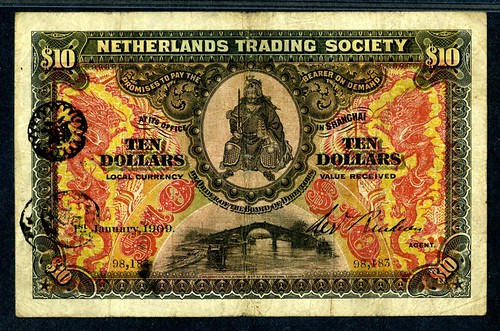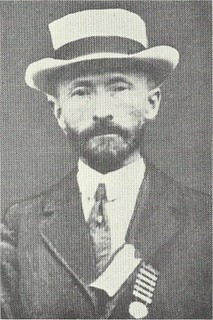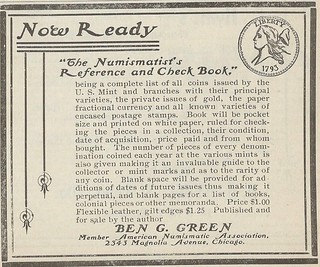
PREV ARTICLE
NEXT ARTICLE
FULL ISSUE
PREV FULL ISSUE
BENJAMIN G. GREEN (1860-1914)
John Lupia submitted the following information from his Encyclopedic Dictionary of Numismatic Biographies for this
week's installment of his series. Thanks! As always, this is an excerpt with the full article and bibliography available online. This
week's subject is dealer Ben Green. -Editor
His religious upbringing and mild manner as a salesman formed him as being one of the most affable and congenial numismatists in the first two decades of the twentieth century, though his life was cut short in 1914. On December 25, 1888, he married Minnie E. Nutt (1866-post 1930), at Dayton, Ohio. They lived at Cincinnati and had a daughter named Mabel (1892-). Green worked for Edward and Theodore Pape and Emil Kugemann in the Cincinnati firm of Pape Bros. & Kugemann selling art moldings, picture frames, and mirrors. In 1890, he left the firm of the Pape Brothers & Kugemann and moved to Chicago where he continued to work as a salesman... On February 20, 1902, he held his first coin auction sale. He held these sales of coin collections on a commission basis in what he called mail auctions conducted at his home in Edgewater, a lakefront community on the North side of Chicago. In all he held eighty-three auctions with the final sale sold posthumously on January 23, 1914. The first eighteen sales from February 1902 to September 1905 were mail bid auction sales printed in 16mo (5-3/4" - 6-3/4" in height). The early catalogues were composed much like the catalogues Green was used to selling picture frame moldings and prosthetic devices that were rather bland and nondescript treating the coins much like merchandise to be sold as retail. The later auctions were all public auctions conducted by veteran Chicago auctioneer Dan Long at Green's office in the Masonic Temple Building. The gross take on his first twenty sales was $40,000.
The first edition was a flexible leather pocket edition with gilt edges, Numismatist's Reference and Check Book: Being A List of Coins Issued By The U. S. Mint And Branches, With Principal Varieties, Private Issues of Gold, Paper, Fractional Currency and Encased Postage Stamps, With Provisions For Checking and Recording The Pieces In A Collection. It was published in several editions, interleaved or not interleaved and in a cheaper binding. A few months after advertising in the Philatelic West he ran his first quarter page ad for the book in the December 1902 issue of The Numismatist and kept an ad running for several years. On September 15, 1902 he opened his own office at the Masonic Temple... It was at the Masonic Temple that Green attracted several important collectors from the Chicago area that fall and winter, including Virgil Michael Brand, and about a year later they formed the Chicago Numismatic Society. In 1941 William G. Jerrems, Jr., the aged first president of the ANA wrote his reminiscences about meeting Ben Green in 1901 and their interest in forming a Chicago Society. In 1904, he served as secretary and librarian of the Chicago Numismatic Society (CNS), which he help found... In the early years many meetings of the CNS were held in Ben Green's salesroom at the Masonic Temple. During his attendance for his last three ANA Annual Conventions, i.e., from 1911 to 1913 he exhibited his collection of about one hundred varieties of encased postage stamps, which was appraised as the finest known. It included the rare Hunt & Nash of Irving House, New York, English Penny Red postage stamp in wide use 1864-1880. In 1913, he was elected to the Board of Governors of the ANA by a vote of 381 in favor. That was pretty good considering Judson Brenner received 384 and Howard Rounds Newcomb 383. Ben Green was well liked and respected throughout his tenure in the field of numismatics. He died on January 17, 1914 of typhoid pneumonia... He was buried on January 20, 1914, in the Rose Hill Cemetery. To read the complete article, see:

Archives International Auctions, Part XXXII U.S., Chinese, Russian & Worldwide Banknotes, Scripophily and Coins April 11-13, 2016 
Click the links! Highlights include: Lot 62: French Guiana. 5 New Francs 1961 Provincial Issue Lot 85: Guadeloupe, 1 Noveau Franc on 100 Francs Lot 104: Reserve Bank of India "Persian Gulf Note" Lot 111: Government of Iraq 10 Dinars of King Faisal II Lot 201: Philippine Islands Silver Certificate Unique Presentation Proof Lot 255: Francis Spinner Letter, 1871. Lot 479: Copper Printing Plate Engraved By William Kneass, Chief Engraver Lot 499: U.S. Legal Tender Treasury Note, Unique Presentation Proof, $10, Series of 1890 Lot 1056: Lao 1948 Unlisted Color Trial Specimen Essay Banknote Lot 1351: Vladikavkaz Railroad Company 1919 Interest Bearing Loan Note Rarity Lot 2053: Bank of China, 1918 "Tsining / Shangtung" Issue Rarity Lot 2258: Deutsch-Asiatische Bank, 1907 "Peking" Branch Rarity Lot 2319: Peiyang Tientsin Bank, ND (1910) Tael Issue Lot 2263: Netherlands Trading Society, 1909 Issued Banknote View the Virtual Catalog Download the Catalog in PDF format ARCHIVES INTERNATIONAL AUCTIONS, LLC 1580 Lemoine Avenue, Suite #7 Fort Lee, NJ 07024 Phone: 201-944-4800 Email: info@archivesinternational.com WWW.ARCHIVESINTERNATIONAL.COM Wayne Homren, Editor The Numismatic Bibliomania Society is a non-profit organization promoting numismatic literature. See our web site at coinbooks.org. To submit items for publication in The E-Sylum, write to the Editor at this address: whomren@gmail.com To subscribe go to: https://my.binhost.com/lists/listinfo/esylum All Rights Reserved. NBS Home Page Contact the NBS webmaster 
|

